📞+86 153 7530 2641 📧 hongjing.Wang@feichuncables.com
In-Depth Analysis of the Westport Port Project in Western Australia: The Huge Demand for Port Cables and Crane Cables for Australia’s New Generation of Green Hubs
Discover how the Westport Port Project in WA is set to transform Australia's trade. Learn about the massive demand for high-performance port and crane cables, vital for powering automation and green initiatives in this next-gen hub. Westport #PortCables #GreenPorts #AustraliaTrade
hongjing.Wang@Feichun
7/2/20257 min read
I. A New Era of Port Construction in Australia: The Rise of High-Performance Port Cables
Australia’s maritime infrastructure is the backbone of its economy, facilitating the export of minerals, agricultural products, and manufactured goods to global markets. With a coastline stretching over 34,000 kilometers, the nation’s ports handle an impressive 1.6 billion tonnes of cargo annually, making them critical to both domestic prosperity and international trade (Australian Bureau of Statistics). However, many of Australia’s major ports are aging, with infrastructure that struggles to meet the demands of modern shipping, including larger container vessels and increasing trade volumes.
The Westport Port Project in Western Australia represents a bold step into a new era of port construction. This $7.2 billion initiative aims to build a state-of-the-art container port in Kwinana to replace the 128-year-old Fremantle Port, which is nearing capacity (Westport Official Website). The project is not just about expanding capacity; it’s about creating a sustainable, automated, and efficient hub that will serve Western Australia’s trade needs for the next 50 years. Central to this transformation are high-performance port cables and crane cables, which act as the “nervous system” for powering and controlling advanced equipment like automated cranes, Automated Guided Vehicles (AGVs), and shore power systems.
These cables must withstand the harsh marine environment—salt spray, UV radiation, humidity, and mechanical stress—while adhering to stringent Australian standards like AS/NZS 2802 and AS/NZS 1747:2022. This article explores the Westport Project’s background, its infrastructure demands, the critical role of cables, and its far-reaching economic impacts on Australia, the global market, and businesses, particularly those in the cable and automation sectors.
Australia’s Main Ports and Their Ages
Australia’s major ports have long histories, reflecting their evolution alongside the nation’s trade growth. Below is an overview of key ports and their approximate ages:


These ports, many established in the 19th century, face challenges due to aging infrastructure and increasing trade demands. Fremantle Port, for instance, handles around 800,000 containers annually but is projected to reach its capacity of 1.4 million TEUs by the late 2030s (Westport WA). The Westport Project aims to address these limitations by providing a modern, scalable alternative.
II. Overview of the Westport Project: A Vision for Next-Generation Port Cables
2.1 Project Background
Fremantle Port, operational since 1897, has been a cornerstone of Western Australia’s economy, servicing Perth and its surrounding regions for over a century. However, its infrastructure is outdated, and it struggles to accommodate the larger container ships that dominate modern shipping. Modelling indicates that Fremantle and its surrounding road and rail networks will reach capacity within the next two decades, potentially costing the Western Australian economy $5 billion annually if not addressed (Western Australian Government).
To tackle this, the Western Australian Government established the Westport Taskforce in 2017 to explore long-term solutions. After evaluating 25 options across Fremantle, Bunbury, and Kwinana, the taskforce selected Kwinana’s Industrial Belt as the ideal location for a new deep-water port due to its strategic position and existing industrial infrastructure (Westport Project Stages). The project, now in its detailed planning phase, is a multi-billion-dollar initiative to relocate container trade from Fremantle to Kwinana, allowing Fremantle to evolve into a hub for other cargo types or urban redevelopment.
2.2 Planning Objectives
The Westport Project is designed to meet several ambitious goals:
Deep-Water Port: The new port will accommodate larger container ships, ensuring Western Australia remains competitive in global trade.
Integrated Transport Networks: Direct rail access and upgraded road infrastructure will optimize freight movement, with preliminary modelling suggesting a 30% rail mode share (Westport Rail Network).
Automation and Intelligent Control: The port will leverage advanced automation, including AGVs and automated cranes, to enhance efficiency and reduce operational costs.
Green Energy Integration: Sustainability is a core focus, with plans for shore power systems and renewable energy sources to minimize environmental impact.
Long-Term Scalability: The port is planned to handle trade growth for the next 50 years, with a capacity to process over 3 million containers annually.
2.3 Time Nodes
The project follows a structured timeline based on recent government updates:


III. Key Port Infrastructure Investment Areas: The Demand for Crane Cables and Automation
The Westport Project involves significant investment in infrastructure, with a focus on automation and electrical systems that rely heavily on specialized cables.
3.1 Port Automation and Crane Cables
Automation is a cornerstone of Westport’s design, aligning with Australia’s leadership in automated port terminals, as seen in Brisbane, Sydney, and Melbourne’s Victoria International Container Terminal (WSP). Key automated systems include:
Automated Guided Vehicles (AGVs): These driverless vehicles will transport containers within the port, requiring high-flexibility cables to deliver power and data for precise navigation.
Ship-to-Shore (STS) and Rail-Mounted Gantry (RMG) Cranes: These automated cranes will handle container loading and unloading, operating continuously with minimal human intervention.
Crane Cable Requirements:
High-Flexibility Reeling Cables: Designed for repeated bending and twisting, these cables must endure over a million bending cycles, as specified in AS/NZS 2802 (Standards Australia).
Hybrid Cables: Combining power, control signals, and fiber optics, these cables support integrated automation systems, ensuring seamless communication between equipment.
Mechanical Durability: Cables must resist tension, torsion, and abrasion, with robust sheathing materials like polyurethane (PUR) or heavy-duty rubber.
3.2 Shore Power Systems and Port Cables
Shore power, or cold ironing, allows berthed ships to connect to the electrical grid, reducing emissions from onboard generators. Westport plans to implement medium-voltage shore power connection stations, aligning with global standards like IEC/IEEE 80005 (Sustainable Ships).
Shore Power Cable Requirements:
Weather Resistance: Cables must withstand salt spray, UV radiation, and humidity, with PUR sheaths offering superior durability (Top Cable).
Arc-Proof Design: Ensures safety in high-voltage applications, preventing electrical faults.
High Flexibility: Allows for repeated connection and disconnection as ships dock and depart.
These cables must comply with AS/NZS 1747:2022 for repair, testing, and accessory installation, ensuring long-term reliability (Techstreet).
IV. Standard Electrical Parameters for Australian Ports
Australian ports, including Westport, require robust electrical systems to power heavy machinery, lighting, and communication networks. While specific parameters vary, general requirements include:


For Westport, these parameters will be tailored to support advanced automation and shore power, requiring cables that meet both Australian (AS/NZS 1747:2022) and international standards (IEC 60092) for marine applications (Eland Cables).
V. Opportunities Facing Cable Companies: Seizing the Port Cable Market
The Westport Project presents a significant opportunity for cable manufacturers, driven by the demand for specialized port cables and crane cables.
5.1 Market Capacity and Product Adaptation
The project’s $7.2 billion budget and focus on automation and sustainability create a substantial market for cables. Key standards include:
AS/NZS 2802: For reeling and trailing cables used in cranes and AGVs.
AS/NZS 1747:2022: Guidelines for cable repair, testing, and accessory installation, reducing maintenance costs.
AS/NZS 5000 series: For low-voltage cables, ensuring electrical safety.
IEC 60092: International standard for marine cables, critical for shore power systems.
Recommended Cable Types:
Reeling Cables: For STS and RMG cranes, offering high flexibility and durability.
Hybrid Cables: Combining power, control, and fiber optics for automation systems.
Shore Power Cables: Weather-resistant and arc-proof for ship-to-shore connections.
Fiber-Integrated Cables: For high-speed data transmission in intelligent control systems.
5.2 Compliance and Certification
Cable companies must ensure products are certified to meet Australian and international standards, undergoing rigorous testing for mechanical durability, electrical performance, and environmental resistance. Companies like Austech Cables, which produce UV-stabilized, RoHS-compliant marine cables, are well-positioned to meet these requirements (Solar4RVs).
VI. Impact of the Westport Port Project on Australia’s Economy, the World, and Businesses
The Westport Project is poised to transform Western Australia’s economy, enhance global trade, and create opportunities for businesses.
6.1 Economic Impact on Australia
Job Creation: The project will generate thousands of jobs during construction (2026–2028) and operation, boosting employment in Kwinana and surrounding areas (Westport LinkedIn).
Trade Efficiency: By accommodating larger ships and increasing capacity to over 3 million TEUs, Westport will reduce trade bottlenecks, saving an estimated $5 billion annually in economic losses.
Infrastructure Development: Upgrades to road and rail networks, including a 30% rail mode share, will enhance regional connectivity (Westport Rail Network).
6.2 Global Trade Impact
Increased Capacity: Westport will strengthen Australia’s role in global supply chains, particularly with Asia, a key market for minerals and agricultural exports.
Sustainability Benchmark: The port’s green initiatives, like shore power, align with global trends toward eco-friendly port operations, potentially influencing international standards (BMT).
6.3 Business Opportunities
Cable and Automation Industries: The demand for AS/NZS-compliant cables and automation equipment offers significant opportunities for manufacturers and suppliers.
Construction and Engineering: Firms involved in port design, construction, and rail upgrades will benefit from the project’s scale.
Logistics and Supply Chain: Businesses in freight, logistics, and transport will see increased demand as the port enhances trade efficiency.
VII. Summary and Outlook: The Future of Port Cables in Green Hubs
The Westport Port Project is a landmark initiative that will redefine Western Australia’s maritime infrastructure. By replacing the aging Fremantle Port with a modern, automated, and sustainable facility in Kwinana, it addresses critical capacity constraints while setting a new standard for green port development. High-performance port cables and crane cables are essential to this vision, powering automated systems and shore power facilities while withstanding harsh marine conditions.
For port operators, prioritizing AS/NZS-compliant cables ensures safety and reliability. For cable manufacturers, aligning products with standards like AS/NZS 1747:2022 and IEC 60092 positions them to capitalize on the project’s $7.2 billion market. As Australia invests in its port infrastructure, the Westport Project underscores the importance of innovation and sustainability, paving the way for a new era of smart, green ports that will drive economic growth and global trade for decades to come.


How to Reach Us
Get in Touch
SiteMap
Product Catalogue
Reeling Cable
Festoon Cable
Shore Power Cable




Scan to add us on WeChat
